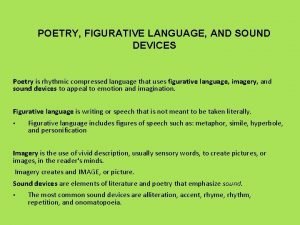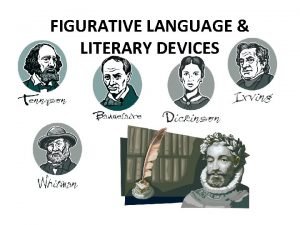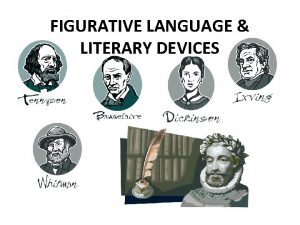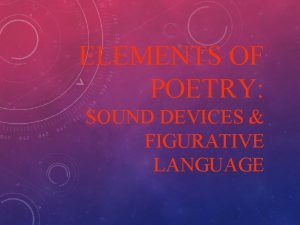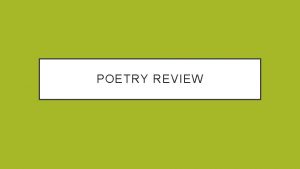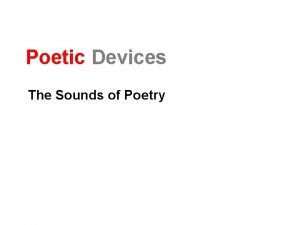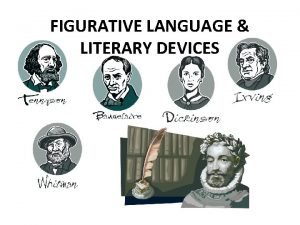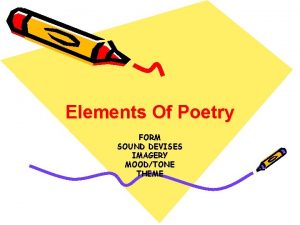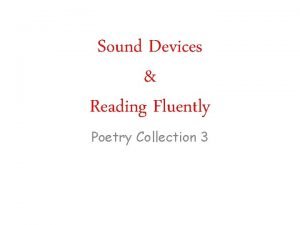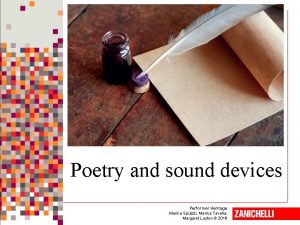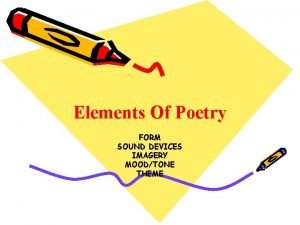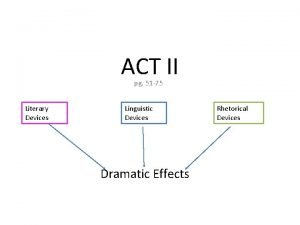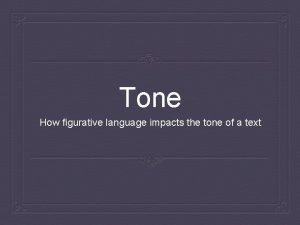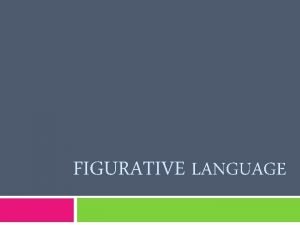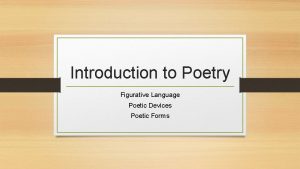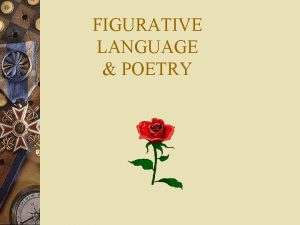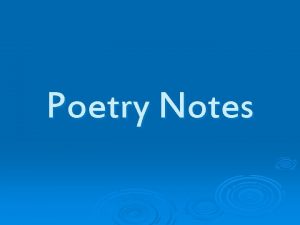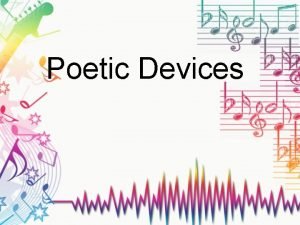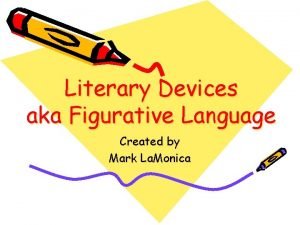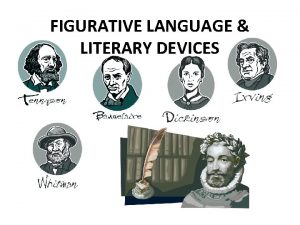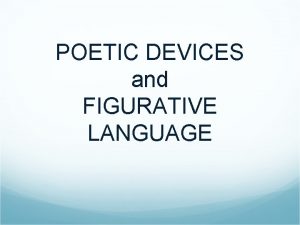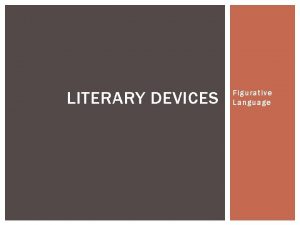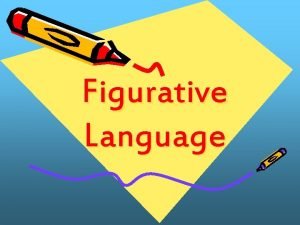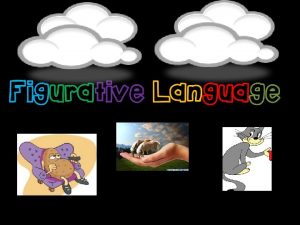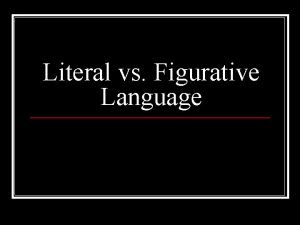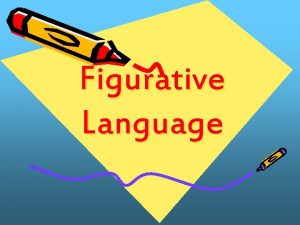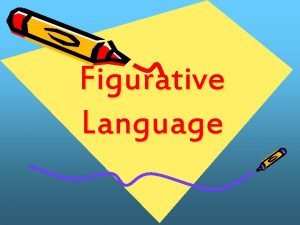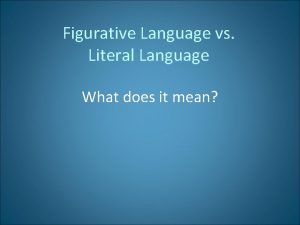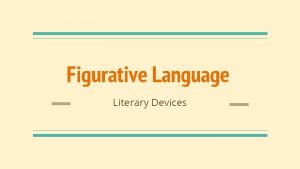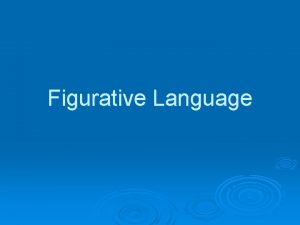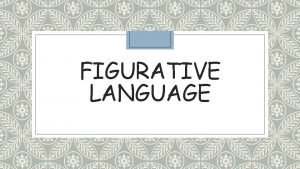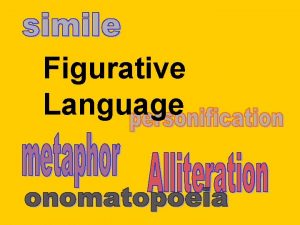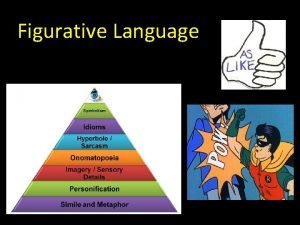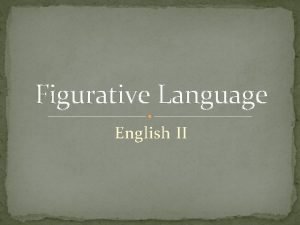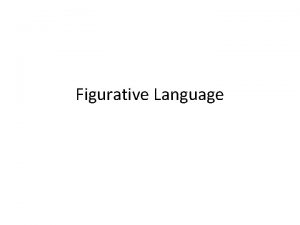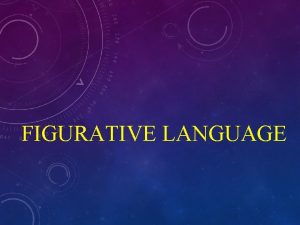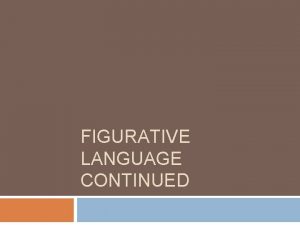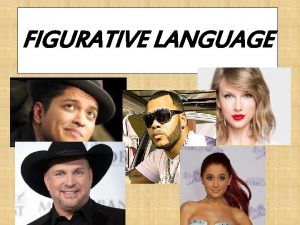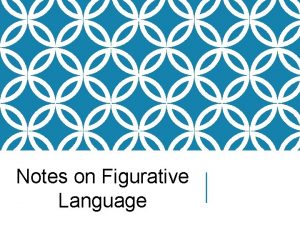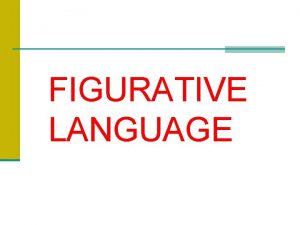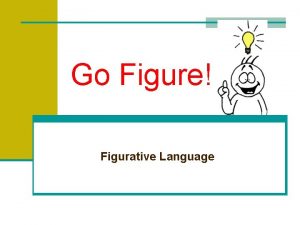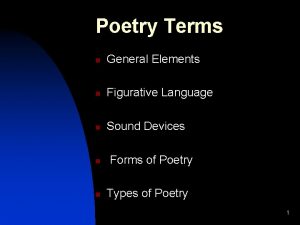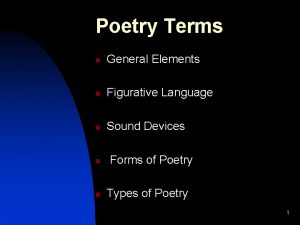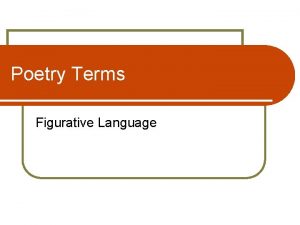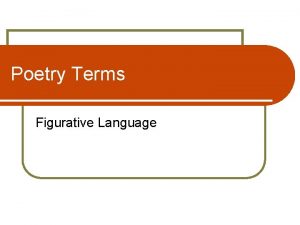Poetry Terms General Elements Figurative Language Sound Devices

































- Slides: 33

Poetry Terms • General Elements • Figurative Language • Sound Devices • Forms of Poetry • Types of Poetry 1

Elements: Stanza • Formal division of lines in a poem • Considered a unit • Separated by spaces • Couplets: two lines • Quatrains: four lines 2

Speaker • Imaginary voice assumed by poet • Often not identified by name • May be person, animal, thing, or abstraction • E. g. : Dickinson as dead person: “Because I could not stop for Death-He kindly stopped for me-” 3

Tone • Writer’s attitude to audience and subject § E. g. : formal or informal serious, playful, pompous bitter, ironic, personal sympathetic, friendly grieving, sarcastic, harsh 4

Allusion • Reference to well-known person, place, event, literary work, or art • Usually to the Bible or to mythology • E. g. : “The Magi. . . were wise men. . . who brought gifts to the Babe in the manger. ” 5

Connotation • Ideas or meanings associated with a word (in addition to dictionary definition) • E. g. : “caged bird” = sad, trapped creature “previously owned vehicle” = used car “vacation spot” = lake Compare: fragrance, smell, stench 6

Denotation • Dictionary definition of a word • Independent of other associations (connotations) • E. g. : lake • Denotation: inland body of water • Connotation: vacation or fishing spot 7

Paradox • Statement that seems contradictory but may be true • Surprising, catches reader’s attention • E. g. : “Youth is wasted on the young. ” “The more things change, the more they stay the same. ” 8

Symbol • Object has own meaning but also abstract idea represents • Stands for something else • E. g. : • Flag symbolizes country • Scarlet ibis symbolizes Doodle and other people who struggle 9

Figurative Language • Writing not meant to interpret literally • Compares dissimilar things • Creates vivid impressions • Metaphors, similes, personifications • E. g. : • “My black eyes are coals burning Like a low, full jungle moon Through the darkness of being” 10

Fig Lang: Metaphor • Figure of speech • A comparison • One thing spoken of as if it is something else • E. g. : “Poetry is a river. ” “The sky is a patchwork quilt. ” 11

Fig Lang: Simile • Figure of speech, comparison • Uses like or as to compare two unlike ideas • E. g. : • “The morning sun is like a red rubber ball. ” • “Does it dry up, like a raisin in the sun? ” 12

Fig Lang: Imagery • Descriptive or figurative language • Creates word pictures (images) • Details of sight, sound, taste, touch, smell, or movement • E. g. : “ghostly marching on pavement stones” “wind-tanned skin” “wise black pools” 13

Fig Lang: Personification • Figurative language • Nonhuman subject given human characteristics • E. g. : “The wind danced in the trees. ” Daffodils “tossing their heads in sprightly dance” Storm “tosses her hair, throws back her head, and closes her eyes” 14

Fig Lang: Extended Metaphor • Writing about a subject as if it were something else • Comparison several lines long or • E. g. : “caged bird” becomes who is not free entire poem person “broken-winged bird that cannot fly” becomes life without a dream 15

Fig Lang: Sensory Words/Lang • Writing that appeals to the senses images • Provides details related to senses • E. g. : feeling the sun beating head down on one’s 16

Sound Devices: Onomatopoeia • Words that imitate sounds • E. g. : murmur, thud, sizzle, hiss, pop, cuckoo buzz, bang, • E. g. : Poe’s “Bells” “Of the bells, bells” ringing, chiming, jangling, rangling, clash, roar” 17

Sound Devices: Assonance • Repetition of vowel sounds followed by different consonants in 2 or more stressed syllables • E. g. : “weak and weary” “child of silence” “so rolling…a stone” 18

Sound Devices: Alliteration • Repetition of initial consonant sounds • Emphasizes words, imitates sounds, creates musical effects • E. g. : “I grew like a thin, stubborn weed, watering myself whatever way I could. ” “Once upon a midnight dreary, while I pondered weak and weary. ” “The fair breeze blew, the white foam flew. ” 19

Sound Devices: Rhyme • Repetition of sounds at ends of words • End rhyme vs. internal rhyme • E. g. : “Swans sing before they die—’twere no bad thing Should certain persons die before they sing. ” (end) “Once upon a midnight dreary, while I pondered, weak and weary. ” (internal) • Exact rhyme vs. slant rhyme (slant rhyme – similar but not identical sounds) • E. g. : ball and hall (exact) hold and bald (slant) 20

Sound Devices: Repetition • Use of any language element – a sound, word, phrase, clause, or sentence – more than once • Used for musical effects and for emphasis • E. g. : • Alliteration, assonance, rhyme, rhythm repeat sounds • Refrain repeats line/s • “You liked winning…You liked writing…You liked all the faces…” 21

Sound Devices: Refrain • Regularly repeated line or group of lines In music: a chorus E. g. : Quoth the raven, “Nevermore. ” “Macavity, there’s no one like Macavity. ” 22

Sound Devices: Rhythm • Pattern of beats or stresses • Some poems have a specific pattern or meter • E. g. : “There was a young lady named bright Whose speed was far faster than light; ” • Prose and free verse use natural of everyday speech rhythms 23

Forms of Poetry: Fixed Form • Stanzas have repeated or predictable patterns • Words in each stanza may rhyme or sound alike • Length and rhythm of stanzas are related • Number of syllables in line may be fixed 24

Forms of Poetry: Free Form or Free Verse • Lacks structure or pattern • Words may not rhyme • Lines do not match in number of syllables, length, or rhythm 25

Types of Poetry: Sonnet • 14 -line lyric poem • Formal patterns of rhyme, rhythm and line structure Two types: English, or Shakespearean (3 quatrains + couplet) Italian, or Petrarchan (octave + sestet) 26

Types of Poetry: Haiku • 3 -line verse form • 1 st and 3 rd lines: 5 syllables (? ) • 2 nd line: 7 syllables (? ) • Single vivid emotion • Images from nature • E. g. : Basho: • “furu-ike ya “An old pond kawazu tobi-komu A frog jumps in Mizu-no-oto” The sound of water” 27

Types of Poetry: Lyric Poem • Brief poem • Musical verse: uses rhythm, alliteration, and rhyme • Observations and feelings of one speaker • Sung with lyre in ancient times 28

Types of Poetry: Narrative Poem • Tells a story in verse • May be an epic or a ballad • E. g. : • “Casey at the Bat”: humorous narrative poem • Poe’s “Raven”: serious narrative poem 29

Types of Poetry: Ballad • Songlike poem that tells a story • Often adventure and romance • Most written in 4 to 6 -line stanzas, regular rhythms and rhyme schemes, often a refrain 30

Types of Poetry: Limerick • Humorous, rhyming, five-line poem • Specific meter and rhyme scheme • E. g. : Edward Lear: “There was an Old Person whose habits, Induced him to feed upon rabbits; When he'd eaten eighteen, He turned perfectly green, Upon which he relinquished those habits. ” 31

Types of Poetry: Concrete Poem • Poem with shape that suggests subject. . . t e a r s 32

Types of Poetry: Dramatic Poem • Uses techniques of drama • Writer tells a story • Character’s own thoughts/words • E. g. : Poe’s “Raven” uses dramatic dialogue • Dramatic monologue: 1 person speaks to silent listener 33
 Figurative language
Figurative language Enjambment example
Enjambment example Poems with sound devices and figurative language
Poems with sound devices and figurative language Repetition in language
Repetition in language Twinkle twinkle little star figurative language
Twinkle twinkle little star figurative language What language is this
What language is this Literature sound devices
Literature sound devices Wave onomatopoeia
Wave onomatopoeia Quatrain
Quatrain What are sound devices in a poem
What are sound devices in a poem Sound devices definition poetry
Sound devices definition poetry Poetry and sound devices zanichelli
Poetry and sound devices zanichelli Mood
Mood 75 literary terms elements and devices
75 literary terms elements and devices Is tone a figurative language
Is tone a figurative language Figurative language onomatopoeia
Figurative language onomatopoeia Figurative language in introduction to poetry
Figurative language in introduction to poetry Examples of figurative language poems
Examples of figurative language poems Meter in figurative language
Meter in figurative language Introduction to poetry billy collins poetic devices
Introduction to poetry billy collins poetic devices Literary devices of fiction
Literary devices of fiction Literary devices figurative language
Literary devices figurative language Figurative language examples
Figurative language examples Poetic device
Poetic device Figurative language and literary devices
Figurative language and literary devices Literary elements vs techniques
Literary elements vs techniques Polynomial degrees and terms
Polynomial degrees and terms What are like terms
What are like terms The zebras cried when the wise old elephant died
The zebras cried when the wise old elephant died Figurative language is language that: *
Figurative language is language that: * Literal language vs figurative language
Literal language vs figurative language Literal language and figurative language
Literal language and figurative language Literal language v figurative language quiz (+ answer key)
Literal language v figurative language quiz (+ answer key) My brother is a dragon metaphor
My brother is a dragon metaphor
